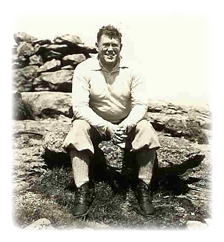Biography of
Russell M.L. Carson
| Russell Carson (1884-1961) was among the earliest to know and appreciate the Adirondacks and to infuse his love of them into others. A native of Glens Falls, he was an influential figure in the insurance industry, garnering significant recognition for his accomplishments. He served in the Armed Forces, as a Captain the in the 105th Infantry, New York National Guard. Imbued with a sense of duty to community, he was elected to a number of education-related posts including serving on School Boards and related Associations, and was a pillar of the Rotary Club of Glens Falls. The latter organization helped advance the cause of his great love of the mountains. Russ loved to delve into the history of the mountains – still-recent history, in the early 1920’s. He was recognized as an authority by Bob and George Marshall, the first people ever to complete the ascent of the 46 highest summits, in 1925. Mountain surveying was not the exact science in the early 20th century that it is today, and Russ actually advised the Marshalls to add four additional peaks to the then-known list of 42, leading to the historically important “46” still acknowledged today.
He wrote a recurring newspaper column for the Glens Falls Post Star called "The Footpath", chronicling the activities of the nascent Adirondack Mountain Club. His documentation included sketches of each of the High Peaks, indicating their first ascents, features, and how they had come to be named. Russ believed strongly in the importance of mountain names, and was influential in the naming of some of the peaks. A famous quote summarizing Russ' philosophy was, “True Adirondack lovers feel that the mountains which are most appropriately named are those that perpetuate the memory of men who have had a close connection with the region.” As a way to stimulate attendance at Rotary Club meetings and at the same time to popularize the mountains, Russ organized a “climbing contest”. At each of forty two Rotary meetings, the name of one of the High Peaks would be drawn out of a hat, and Russ’ informative sketch would be read to the assemblage. Everyone present would be credited with points equaling the height of the mountain in feet. Many of these people went on to appreciate the Adirondacks, and a few went on to climb them in fact. Some of them were among the early members of the Adirondack Mountain Club (ADK) in 1922. Russ himself was a founding member, and later became President of the ADK in 1930-1931. Eventually, Russ assembled the notes, sketches, and history into the first trail guide to the High Peaks, Peaks and People of the Adirondacks. This book, whose proceeds Russ later donated to the ADK, was hugely influential in popularizing hiking in the Adirondacks, and was adopted as the point of reference by one of the earliest hiking clubs, The Forty Sixers of Troy, later to become the Adirondack Forty Sixers. Always a conservationist, Russ did all he could to ensure the long-term preservation of the wilderness values he held. His efforts as a member of the Glens Falls Tree and Recreation Commission and the Wilderness Society of New York, as Vice President of the Adirondack Historical Museum at Blue Mountain Lake, and as a trustee for the Association for the Protection of the Adirondacks, set an example that has helped ensure the preservation of the wilderness experience we enjoy today. ~ ~ ~ |
